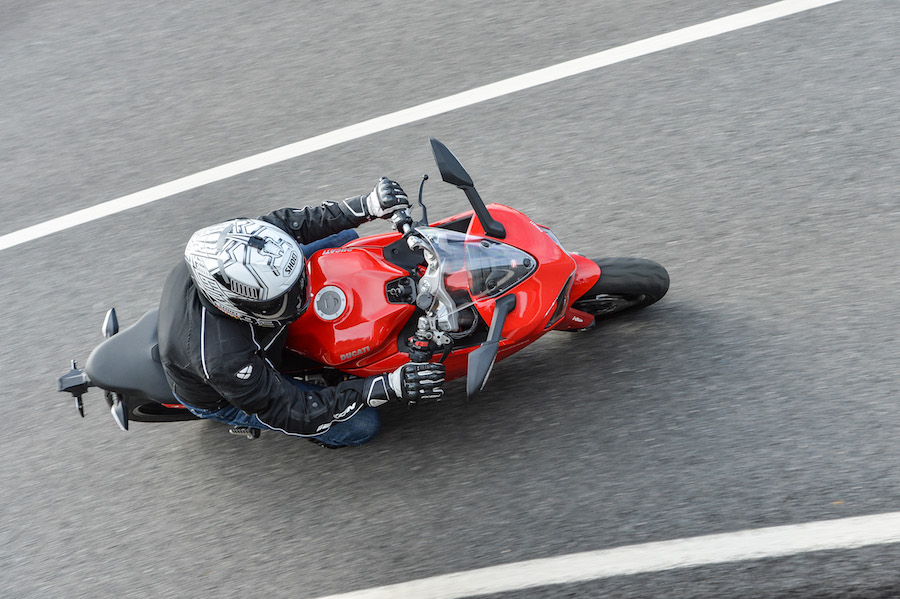The new SuperSport hits a new balance between road rideability and racetrack agility – has Ducati found the perfect blend?
Many of us dream of riding a full-blooded superbike through our favourite bitumen twisty bits and on to the latest weekend leather-clad hangout; however, real-world practicality and scratching fantasies do not always make good bedfellows. Models such as Ducati’s 1299 Panigale may be supermodel gorgeous, but they lack everyday useability.
That’s not to knock people who ride their thoroughbred superbikes regularly, even commute on them daily – all power to you I say. But as the riding population grows older, an increasing number of buyers appear to be looking for a bike that delivers superbike-type performance for the road, coupled with ergonomics to suit. The answer may just be Ducati’s new SuperSport model, and if you want a little more sport in your SuperSport, then the S version will get you there.
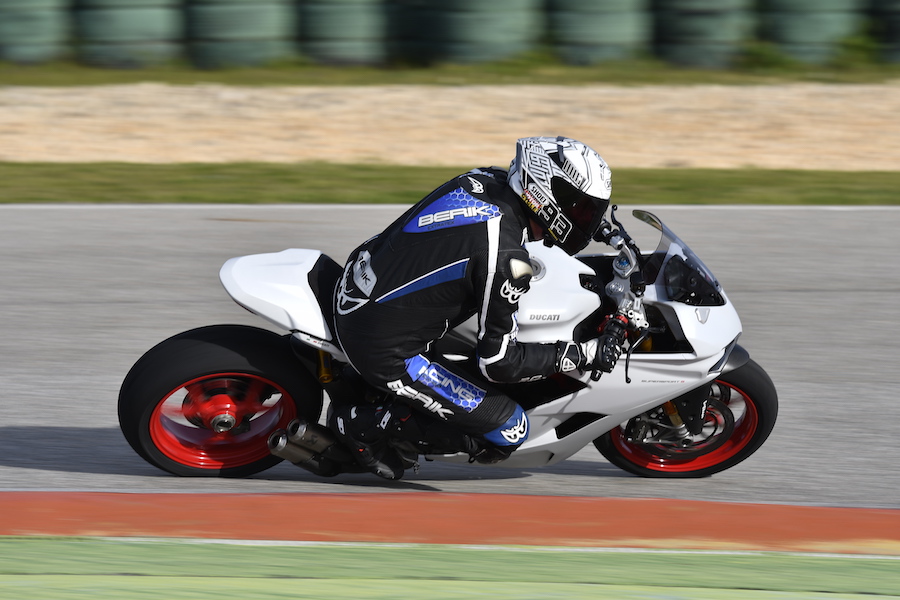
For this new model, Ducati has resurrected the famous SuperSport name, but after riding the bike at the world launch in Sevilla, Spain, I think RoadSport would have been a more apt name. This bike delivers usable real-world sportsbike performance by the bucketload, with enough kept in reserve for the odd trackday. As it now seems to do with monotonous regularity, the Bologna-based manufacturer has filled a void in its model line-up that we didn’t even know existed.
Two facets of the SuperSport came to the fore at the launch. The base model SuperSport was put through its paces on the local roads, ranging from smooth and fast fast-flowing bends to narrow cobblestone streets of the local villages. The up-spec S model was saved for a bit of track fun at the entertainingly technical Circuito Monteblanco.
Powering both variants is Ducati’s delightfully punchy liquid-cooled 937cc Testastretta 11º V-twin. Now in its Euro 4 compliant configuration, the fuelling has been re-mapped to shift power and torque delivery lower into the rev range. According to Ducati, a whopping 80 per cent of the V-twin’s 96.7Nm of torque is available at just 3000rpm, peaking at 6500rpm, with its 83.1kW peaking at 9000rpm. These numbers sound very un-sportsbike-like, until you discover that the 916 produced roughly the same amount of power – and nobody ever called that bike a middleweight.
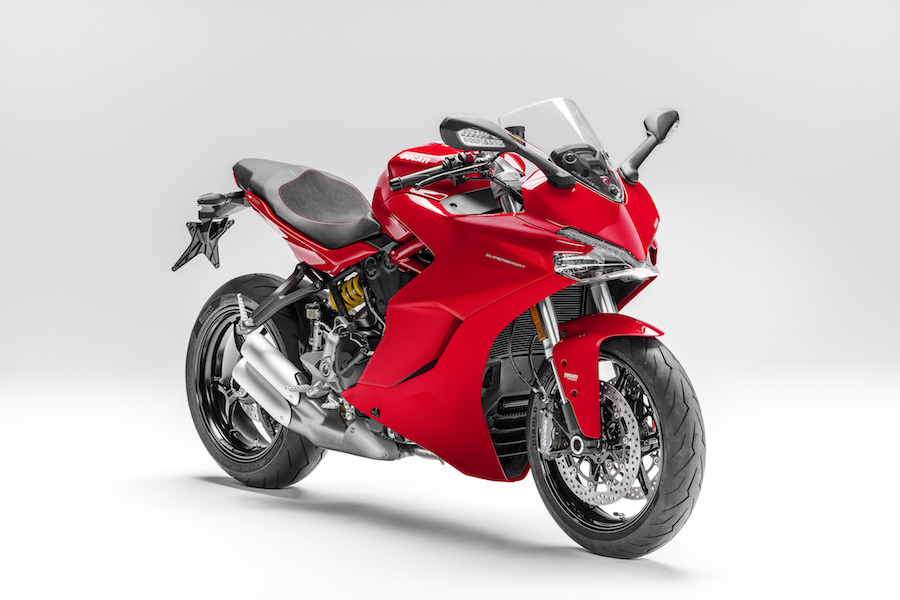
The standard model comes in Ducati red with a red frame and black wheels.
But why has Ducati targeted low-end grunt? This comes back to my RoadSports moniker. The new SuperSport has been designed for more frequent and extended fun time, and as it doesn’t have to comply with the rules of a racing category, there’s been no compromise on usa–bility and comfort in search of lap times. That’s not to say it doesn’t look sporty or go hard – the thing looks like it’s doing 100mph while sitting on its sidestand.
The fairing is less aggressive than on the Panigale, sitting higher and wider and without a full bellypan, but the proportions are spot on and mask the increased dimensions. The lines of the bike flow almost seamlessly from nose to tail thanks to the hidden fairing bolts, and the sleek screen gives no hint of its 50mm adjustability. The designers have also managed to cram the large catalytic converter required for Euro 4 compliance into a small and mostly hidden area, using the stubby twin-exhaust side-cans to mask some of the bulk.
As with any bike, there are a few things to nit-pick. Taking an engine from an existing model does come with its compromises, and in the case of the 937cc Testrasetta engine, it’s the plumbing around the back which can’t be hidden by the fairing. And while the fairing itself has lovely flowing curves, the thinness of the material in places gives a slight budget feel not typically associated with Ducati.
ABS level 2 and traction control level 3 were more than adequate for the combination of quality road surface and Pirelli Diablo III tyres, with just the occasional flash of the DTC light on some corner exits to remind me I was well looked after.
Out on the open road, the easy-riding comfort of the bike came to the fore. We are not talking adventure-bike comfort here. I did find the Marzocchi/Sachs suspension package of the standard model quite firm, and my left wrist paid the price during the 2.5-hour ride, but my knees escaped pain-free. It’s in road rideability that the SuperSport scores highly – it’s child’s play to drive it out of corners like a pro. A confidence-building slow in/fast out approach is the mantra of this engine.
I often found myself shifting up a gear well before the 9000rpm peak power point and simply basking in the low-end grunt of the engine. Riding high in the rev range is also a tasty option, and it’s where you will begin to notice the red rev-limiter lights flashing on the dash a little earlier than you expect from a sportsbike. The first approach makes for more fun; the second makes a better sound from the exhaust. Gearing is well suited to the engine’s strong points with 120km/h requiring just 4000rpm.
Chassis geometry is on the sporty side with 24º of rake, 91mm of trail and a 1478mm wheelbase. As a comparison, the Panigale 959 has a 24º rake, 96mm trail and 1431mm wheelbase. On the road this translates to a machine with sportsbike manners but less sensitivity on the turn than its sibling. It also seems to ask more of the front tyre when the pace quickens. This isn’t necessarily a bad thing as it provides a more planted feel for those of us not blessed with racer-fast nerve endings. The chassis has a superb neutral feel, and there’s a hell of a lot of feedback from the back end, which loves to squat and bite when the power is applied.

Colourwise, the standard model comes in Ducati red with a red frame and black wheels. The S version comes in Star White Silk with red wheels or classic Ducati Red with black wheels
The not-too-bitey Brembo M4-32 brakes also have a more confidence-inspiring feel than the super-powerful Panigale kit, however, I found that on the initial squeeze the lever was a little soft on both of the SuperSport models I rode. Once gripping, they provided proper stopping power and feedback through the lever. Combined with the Bosch 9MP ABS system they allow a little more margin for error should you squeeze a bit harder than expected during a ‘pucker’ moment. There’s a chance the softness I felt could be attributed to the choice of brake pad material.
With the road ride done and dusted, we swapped to a fleet of Star White Silk SuperSport S models and were let loose on the 4.43km Circuito Monteblanco, and again my expectations were flipped on their head. While the Marzocchi/Sachs kit felt a bit too firm on the road, the Öhlins kit felt a little too soft for the track, and as soon as the pace picked up the bike started to move around. But with a little more time I’m sure the softness could be dialled out.
As it was on the road, the rideability of the engine was the talking point of the track test. It took a few laps to get used to a powerplant that liked to be fed the next gear before 9000rpm, but the simplicity with which you can ride the bike made it easy learning. You will rarely find me bullshitting about spinning up the rear wheel of a test bike – my abilities are representative of the ‘normal’ rider. However, the combination of a tidal wave of low-end drive and an impressive amount of feel from the back end was an open invitation to try.
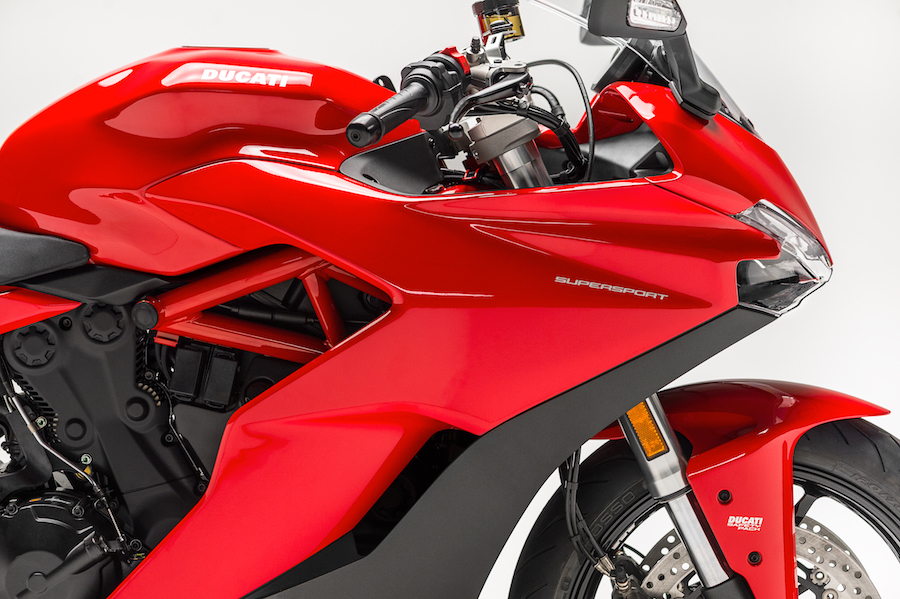
With Sport mode and default TC 3 selected I could get a slight slide at the rear before the spark to the engine was gently interrupted to regain traction. Changing to TC 2 freed up the rear wheel enough to allow proper rear-tyre spin and slide. It would take a full day of familiarisation to work my way up to it before I attempted a similar thing on a high-revving sportsbike, yet there I was having a red hot go after just 20 minutes on the S model.
One major difference between the standard and S models is the Ducati Quick Shift (DQS), which allows the rider to blast up and down the gearbox without having to touch the clutch lever. The downshift function is limited to 9000rpm, any higher and it refuses to work. I found myself clutchlessly clicking down from sixth to third gear into the tight second-gear corner at the end of the 240km/h-plus main straight, then using the clutch for the high-revs downshift into second.
Where the choice between Sport and Touring modes on the road will be a case of personal preference, on the track Sport mode is the only choice, providing a much better kick out of the corners. The slightly lower-set footpegs meant I had to keep my giant flippers high on the ’pegs to stop my toes dragging. So I had no use for the front-wheel-only Level 1 ABS, as I didn’t touch the rear brakes all day. And while the soft initial squeeze of the front stoppers remained, the Brembo brakes didn’t fade, and the front callipers seemed more than happy to look after 100 per cent of the braking duties all day, retaining a good solid lever feel. Trail-braking right to the apex was also easy work.
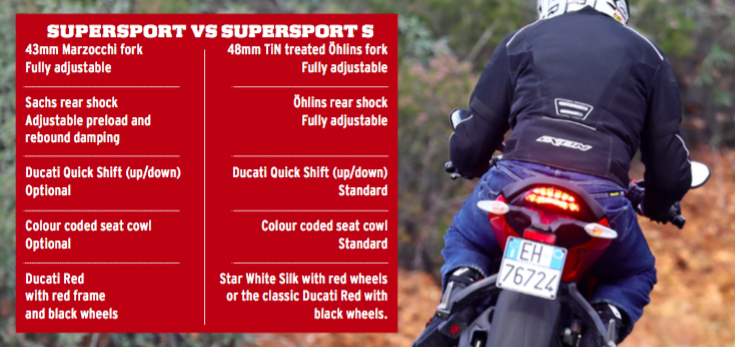
Just like on the road, the chassis steered exactly where I pointed it, and held its line through corners with ease. At no time did I feel the bike was about to bite me. And I was never left wanting more. Those with proper track racing credentials may find the bike falls a little short on the top-end thrills department. For them, there’s the Panigale.
Our one-day, two-part test revealed there’s enough fun and excitement packed into the new SuperSport to keep an experienced rider engaged, but its strongest point is how confidence inspiring it is for those keen on sportier riding and possibly the odd trackday. If you’re not planning on taking your new pride and joy to the racetrack, then it will just as happily spend its days delivering pure sport riding enjoyment on the road, where it has the grace and manners of a June Dally-Watkins graduate – but it can also grow little horns at the flick of a riding mode and the twist of a throttle.
If you’re a sportsbike owner looking to change to something a little more comfortable without sacrificing too much of the sportsbike experience, if you have been dreaming of having an Italian sportsbike in your garage but were concerned about the practicality, or if you’re just a Lorenzo fan with one too many Yamahas in your single-bike collection, then the Ducati SuperSport could be the answer to your ownership dreams.
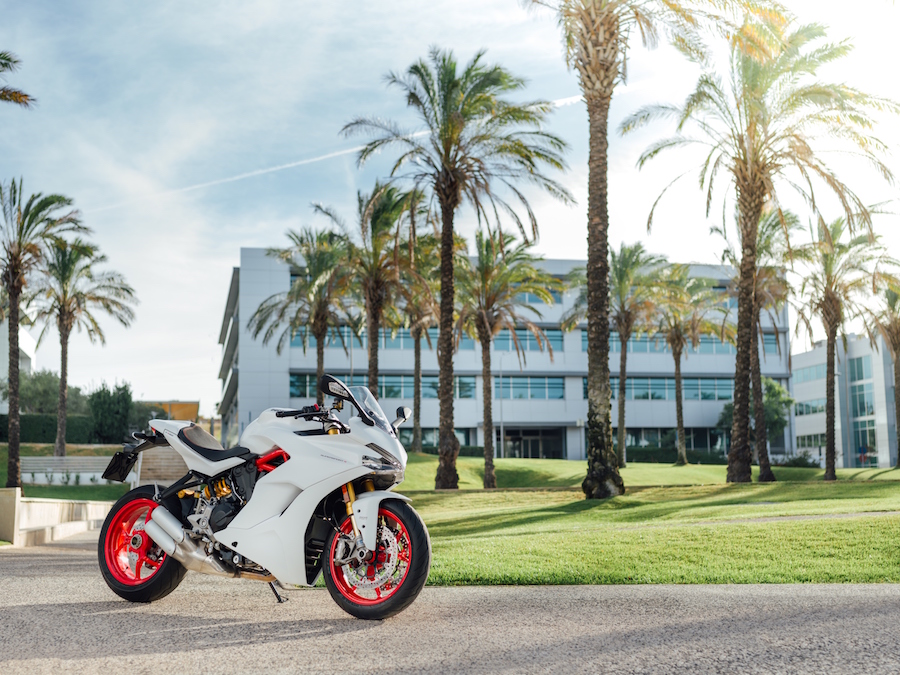
Engine
The original SuperSport was powered by an air-cooled Desmodue engine. The 21st-century incarnation is powered by the 937cc liquid-cooled Testastretta 11o V-twin also found in the Hypermotard, Hyperstrada and Multistrada 950.
Brakes
The dual 320mm discs up front are clamped by Brembo four-piston, radial-mounted monobloc M4.32 calipers. At the rear is a 245mm single disc with a two-piston caliper. Front and rear stoppers are connected to the three-level Bosch 9MP ABS system to form one half of Ducati’s Safety Pack.
The other half is the eight-level Ducati Traction Control (DTC) system.
Suspension
Whichever way you go, you get adjustable kit. On the base SuperSport it’s a fully adjustable 43mm Marzocchi fork and a Sachs shock adjustable for spring preload and rebound damping. Step up to the S model and you receive fully adjustable gold kit in the shape of a 48mm Öhlins TiN-treated fork, and fully adjustable Öhlins rear shock.

1. Öhlins boingers for the S modeln2. Optional seat is available with extranpillion padding and a larger grabrailn3. The SuperSport’s LED monobrow – love it or hate it?
Ducati Quick Shift
Clutchless up and down gear shifts on the S model are provided via Ducati’s DQS feature. And you don’t need to miss out on the clutchless fun if you buy the base SuperSport – the plug-and-play system can be purchased as an optional extra. Note that the DQS will disengage in Urban mode – I wonder how many owners will be returning their SuperSport to the place of purchase, claiming something has gone wrong with the quickshifter.
Frame
The steel tube trellis frame has been sourced from the Monster 821 and helps retain the classic look of the original SuperSport. The crankcase and cylinder heads of the 937cc Testastretta engine have been redesigned externally, allowing the engine to become a fully stressed part of the chassis. The trellis frame connects to the front cylinder head, the steel subframe to the rear cylinder head and the swingarm to the crankcase. The proven configuration saves weight without sacrificing rigidity.
Exhaust system
The Euro 4 emissions regulations have seen some hideous looking exhaust systems appear as manufacturers search for ways to lower emissions while preventing power loss and avoiding the cost of developing a new engine. Ducati has fitted the 2-1-2 system with a large belly cat and silencer, finished off with two stacked end cans.
Electronics
There is a choice of three ride-by-wire modes: Sport, Touring and Urban. The eight-level traction control and three-level ABS can be programmed and stored within each of the three riding modes. ABS and traction control can also be disengaged but will reactivate on next ignition off/on sequence. ABS Level 1 disengages ABS to the rear wheel.

Rider info
The dash is an LCD unit in the fashionable kidney shape of current superbikes. All information is displayed as either a warning light or in a large, easy-to-read LCD font. Speed, engine revs, selected riding mode, ABS and traction control settings are all shown on the main screen.

1. Monster 821-based trellis frame harks back to the unique look of the original SuperSport model
2. ABS and TC can be deactivated, but will reactivate at the next ignition on/off sequence
3. Both models come with top-spec Brembo Monobloc M4-32 brakes
Get connected
Bluetooth
It’s taken a while for motorcycle manufacturers to embrace the idea of smartphones becoming an electronic umbilical cord between bike and rider. The optional Bluetooth module available for the Ducati SuperSport allows the rider to control the phone’s functions via handlebar-mounted switches. This keeps your hands where they are meant to be – on the handlebar. The now obligatory USB port is located under the seat.
REPORT CHRIS DOBIE PHOTOGRAPHY MILAGRO
